Why One Should Migrate to the Shopify Platform
Reasons to migrate to Shopify
One of the main reasons why many e-commerce businesses choose Shopify over other platforms is its ease of use. It is easy to set up and manage, with a central admin that makes it simple to run an entire business from a single location.
Scalability
If you want to grow a store, Shopify offers a wide range of features that can help your business thrive. From multi-location shipping to advanced reporting, you’ll have access to the tools you need at your fingertips.
Merchandising
Shopify has an array of merchandising and marketing options that make it easy to promote products and sell more. From visual displays to product bundles and special offers, one can create a compelling e-commerce shopping experience that will attract and retain customers.
Payments
Shopify supports a number of payment gateways, making it easier to accept payments from customers across the globe. In addition, it allows you to accept non-automatic payments, such as cash on delivery.
Customer Support
Shopify has a robust support team that can be reached 24/7 via phone, chat, and email. They also maintain community forums and an FAQs database to help you get answers to questions quickly.
Cost
Shopify is a highly affordable solution for small businesses and even beginners can start for as little as $29 per month. They offer a variety of plans to suit every type of business, including a free version that can be upgraded as your needs evolve.
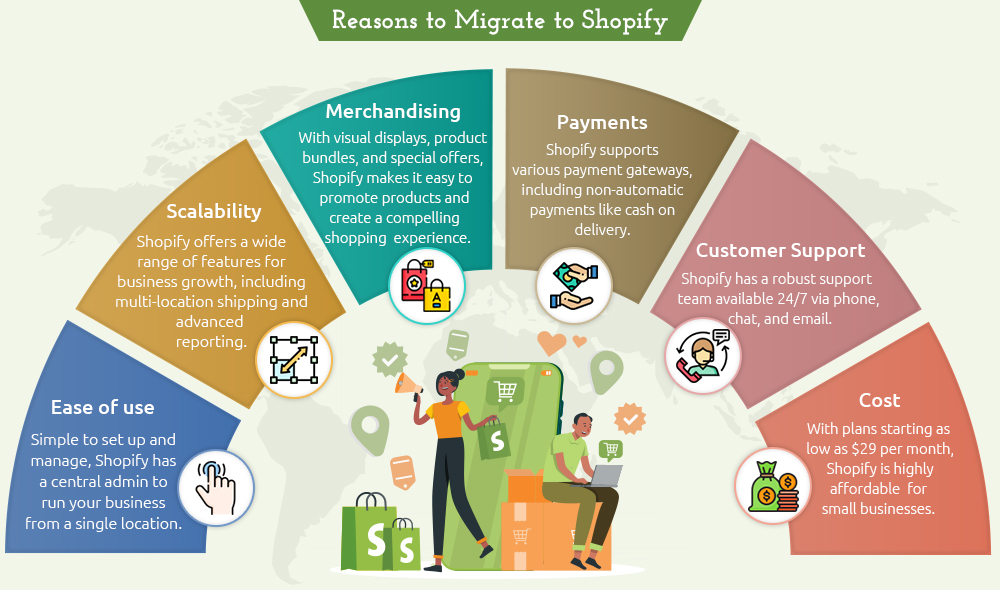
Planning a Successful Shopify Migration
Planning a successful Shopify migration is an important step in business. The process will help to ensure that all aspects of the store are in place and functioning properly, and will make the transition easier for customers.
The first thing to do is set up a checklist of the essential items that need to be migrated, including products, categories, blog posts, and customer information. This will also give you a clear idea of how much data needs to be moved and the steps involved in the process.
Once you’ve completed all of this, it’s time to test your store to ensure that everything is working correctly and that any errors are fixed before launching the site. This includes the payment gateway, shipping options, and the store’s customer account.
In addition, you’ll want to check that the product information is imported correctly and is compatible with the new platform. This is especially crucial if you are selling digital products or services.
The best way to do this is through a manual export and import method, or by using a third-party migration app. The choice of which method to use will depend on developer resources and the amount of data that you need to transfer.
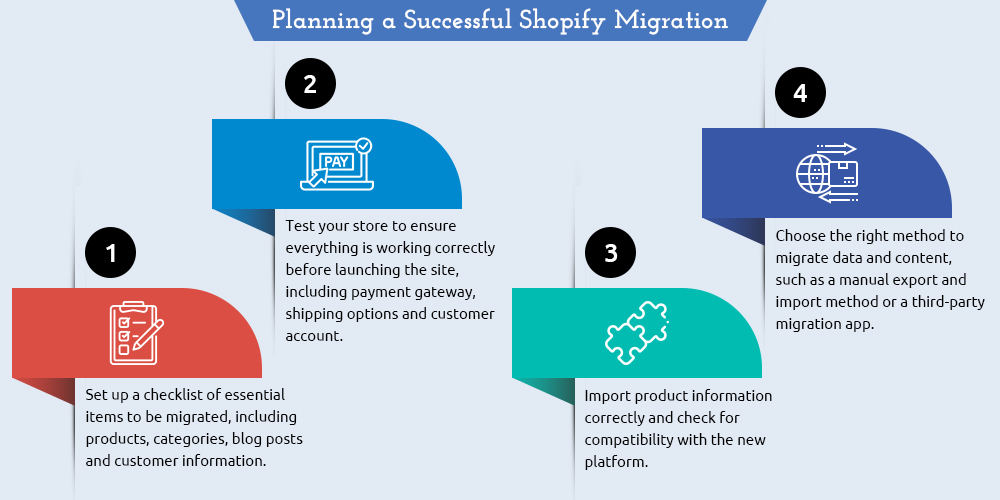
Choosing the Right Shopify Plan and Pricing
There are many factors to consider when choosing the right Shopify plan for business. These include your monthly revenues, required feature set, and customization needs.
Shopify has plan options to choose from: Starter, Basic, Plus, Advanced, and Enterprise. These are designed to help small businesses with different budgets.
The cheapest plan on Shopify is the Starter plan. This plan offers a free store builder and a range of ecommerce tools. It also includes features to accept payments and manage inventory.
For more advanced e-commerce capabilities, one can opt for the Shopify Plus option. This plan allows you to handle higher order volumes and provides additional perks like advanced reporting, priority customer support, and more.
Choosing the right Shopify plan and pricing is important for the online store to grow and thrive. This is because it can have a direct impact on the profitability of your website.
It can also make customers feel secure when buying from your store. Whether they’re paying using cash or a credit card, Shopify ensures that their payment details are safe and secure.
There are many ways to save on r Shopify plan, including choosing a yearly plan instead of paying month-to-month. This can be a great way to cut costs while still getting the most out of your platform.
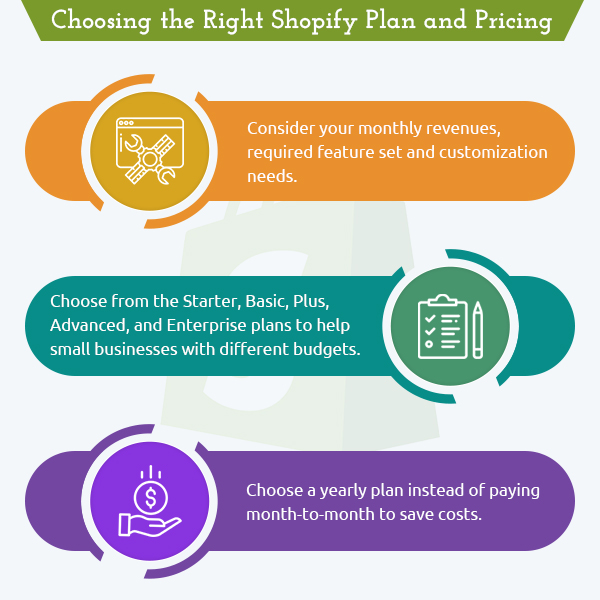
Migrating Data and Content to Shopify
Migrating data and content is an important part of any eCommerce website. It ensures that all your customers and products stay connected after you’ve switched to Shopify.
There are many ways to migrate your data and content to Shopify, and it all depends on what you’re selling. One can either manually copy data and customers from the online store to Shopify or use one of the third-party importer apps available in the Shopify App Store.
Manually importing data to Shopify is the easiest way to transfer everything, but it may not be ideal if you have a large database or don’t have any experience with transferring information. You can also choose to hire an expert to do the job.
Importing Your Product and Customer Data to Shopify
You’ll want to start with products and customers, ensuring that all of their data follow across the pond. This includes product titles, prices, pictures, and any other product details that are important to your customers.
Using the right data migration order is crucial to getting your store set up smoothly, and it will save you time down the road. For example, if you’re moving from WordPress, export your products and customers as CSV files and then use the Shopify importer tool to transfer them to Shopify.
In addition to products and customers, one should also make sure that all supplementary pages are migrated over as well. These include About Us, Return Policy, Privacy Policies, and more. You can create these in Shift4Shop’s page editor, which works like a word processor, so they’re easy to edit and customize.
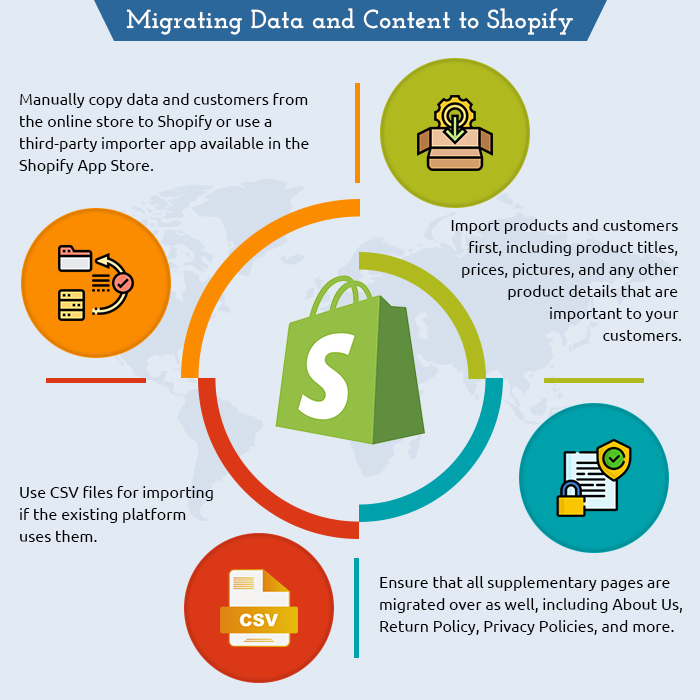
Migrating Third-Party Apps and Plugins in Shopify
When migrating from a different e-commerce platform to Shopify, there is a lot of data that needs to be transferred. This includes product information, blog posts, and customer transactions.
If the existing platform uses CSV files for importing, you can use those to import your data into Shopify. However, if the platform uses a different format for storing data, you’ll have to use a third-party app or API to import this data into Shopify.
Before you begin, make a list of everything that needs to be moved. This includes products, blogs, shipping rules, and customer transactions. It’s also a good idea to think about the design of your current site and how you want to transfer that.
Once you’ve got a list of what needs to be migrated, decide on the ideal migration method. You can choose to do it manually via copy and paste (ouch!), using CSV files, 3rd Party Shopify apps, a migration service, or an admin API.
Choosing the right migration method is crucial to ensure that all of the data will be imported correctly and in the correct format. This process can be time-consuming, so make sure to plan ahead and select the best solution for your business.
Before you start, you should back up the store and import the latest version of your data. You should also verify that your new store is ready to go live. This includes updating DNS records or making other configurations to ensure that traffic is directed to your store.
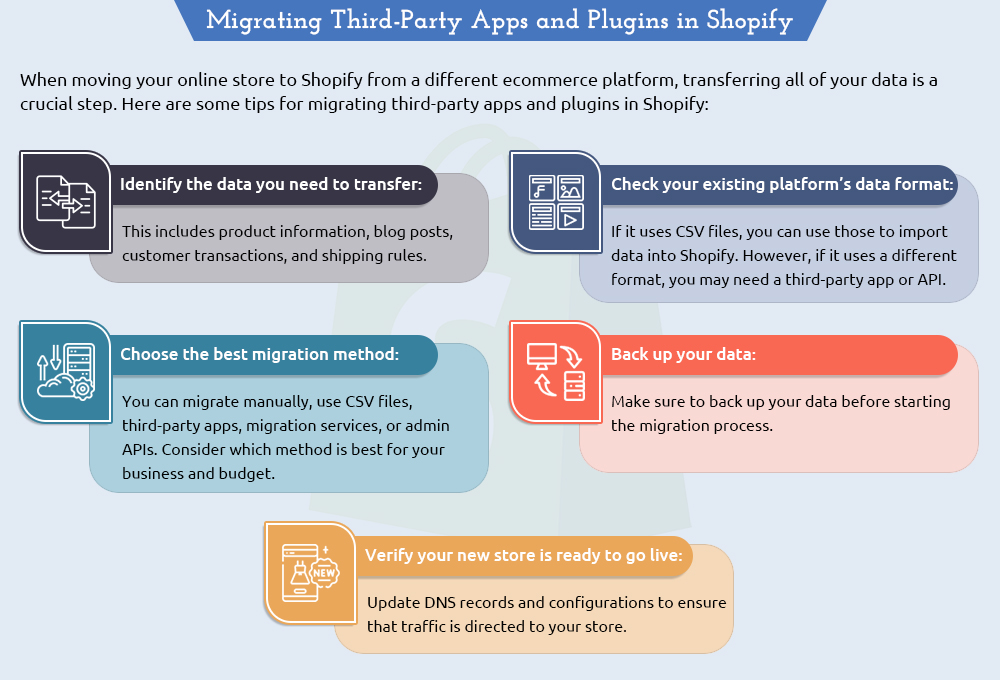
Setting Up Redirects and SEO Optimization After Shopify Migration
When you migrate from Magento to Shopify, it is important that you take the time to set up redirects and SEO optimization. These are essential for maintaining organic traffic after the migration.
You will want to use 301 redirects to inform search bots that your old site has been redirected and to prevent losing valuable page rankings from the move. It’s a time-consuming process but essential to ensure that the new site remains crawlable by Google and that you don’t lose any traffic or important SEO ranking points.
The most important step for setting up redirects is to recrawl your old site’s index using a tool like Screaming Frog or Ahrefs to identify any 404 errors. It’s also a good idea to scan your site’s content for internal links and create 301 redirects where necessary.
After you’ve recrawled your site, check to see that your 301 redirects are active on all pages and that the old URLs are still correctly linked to your new storefront. This can be a daunting task, so you may wish to invest in an app or software that will do this for you automatically.
Once you have all of your redirects in place, it’s time to review and refresh your page titles, content, and other Technical SEO elements. This can be an easy and effective way to maintain original search traffic after the migration.
One can also do a content audit of the blog to make sure you’re capitalizing on the best content trends and practices and are not migrating any useless or duplicated content. This can save you a lot of time and trouble down the line.
Post-Migration Testing and Troubleshooting for Shopify
If you’re planning on launching a new e-commerce store, or just want to update your existing one, you need to make sure that it’s optimized for SEO before you launch it. This includes optimizing for search engine visibility, adding relevant content, and making improvements to the site’s design and layout.
Before you move your store to Shopify, it’s important to perform proper data migration and testing. Here are some of the steps you should follow to ensure that your shop’s data is transferred accurately and seamlessly:
Make a list of all the data that you need to migrate, including product data and customer data. This list may include blog articles, shipping rules, payment methods, and current URLs (think of creating redirects to avoid losing on SEO ranking).
Use this list to ensure that you don’t overlook any data that will be crucial to the shop’s success. Sometimes one might need to get creative with migrations and add new fields or custom code to support the store’s functionality.
Once data has been migrated, it needs to test it on your web browser and mobile device to make sure that everything is working as expected. If you find any bugs or glitches, fix them before launching the Shopify store.
After you’ve tested your site, it’s time to migrate customers’ orders and order data from an old platform to the Shopify store. This includes importing the details of each order, including shipping and payment information.
Best Practices For Shopify Migration
There are a number of key things to consider when migrating to Shopify. It is important to create a plan and timeline for the entire process, considering all of the necessary steps as well as any potential roadblocks.
One of the most crucial steps is to back up all of your store data and ensure that it is secure. This will help to prevent any potential issues and ensure that you have access to essential information should anything go wrong during the migration process.
Creating redirects from the legacy platform to the new Shopify site is another important step in the process. This allows customers and search engines to continue to find your old products, blog posts, and website, even when the old URL is no longer available.
This can be done by exporting the old domain’s site index and then setting up 301 redirects with Screaming Frog or another URL redirect software. This is time-intensive but it will save you from losing any valuable backlinks and page authority that may have been gained over the years.
It is also important to make sure that all of your products, themes, and apps are compatible with Shopify. Using a theme that isn’t compatible with Shopify could result in lost sales and a bad experience for your visitors. Similarly, if an app doesn’t offer the features you need it might be worth looking at alternatives.
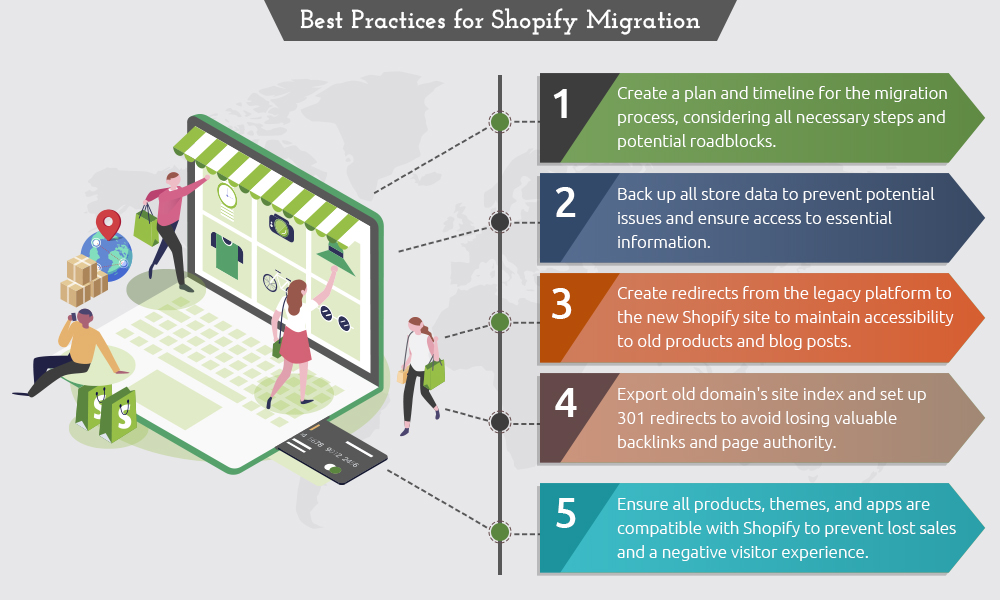
Opal Infotech – Shopify Migration Service Provider
Opal Infotech is a trustworthy and committed web development, e-commerce website design, and digital marketing company. Hire our expert services for Shopify migration from different e-commerce platforms, including Magento, BigCommerce, Prestashop, WooCommerce, Opencart, etc. We offer quick, effective, and affordable Shopify migration solutions.











